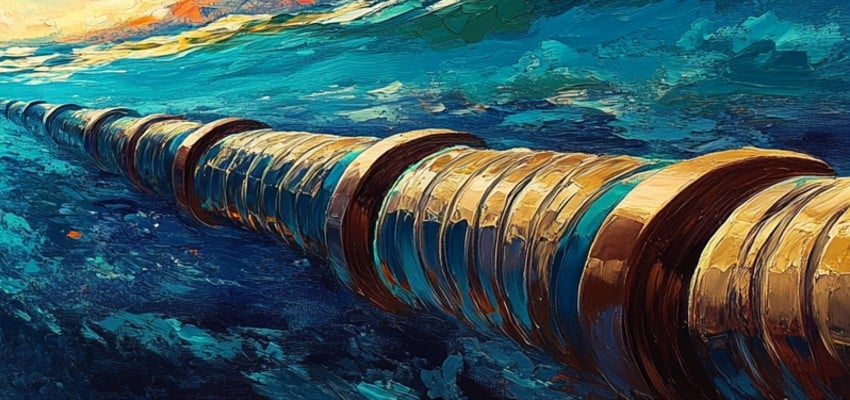Editor’s Note: Undersea cables, the silent workhorses of global connectivity, have emerged as critical infrastructure in the digital age, carrying nearly all international internet traffic. As these lifelines become focal points in geopolitical tensions, tech giants like Meta are stepping in with ambitious projects, such as a $10 billion undersea cable initiative, to enhance connectivity and mitigate vulnerabilities. This article examines the strategic importance of undersea cables, recent threats, and the need for proactive measures to secure the physical and digital arteries of global communication. For cybersecurity, information governance, and eDiscovery professionals, the insights are both timely and essential.
Content Assessment: Undersea Infrastructure: The Hidden Backbone of Global Connectivity
Information - 93%
Insight - 92%
Relevance - 90%
Objectivity - 92%
Authority - 90%
91%
Excellent
A short percentage-based assessment of the qualitative benefit expressed as a percentage of positive reception of the recent article from ComplexDiscovery OÜ titled, "Undersea Infrastructure: The Hidden Backbone of Global Connectivity."
Industry News – Cybersecurity Beat
Undersea Infrastructure: The Hidden Backbone of Global Connectivity
ComplexDiscovery Staff
In contemporary global dynamics, undersea cables have ascended as pivotal strategic assets, encapsulating a duality of opportunity and vulnerability. These fiber-optic juggernauts underpin approximately 99% of global internet traffic, facilitating a vast array of economic and communicative activities. However, their critical role in digital infrastructure renders them attractive targets for espionage, sabotage, and geopolitical maneuvering by state and non-state actors alike.
A case in point is the growing tension surrounding undersea cables, often highlighted by incidents involving hostile entities such as Russia and China. Concerns about national security and economic stability are at the forefront, given the dependency of countries on these underwater veins of connectivity for vital communication and financial transactions. The strategic importance of these cables is further underscored by targeted acts of aggression, such as the suspected sabotage of cables in the Baltic Sea by a Chinese-flagged bulk carrier, Yi Peng 3. This incident, believed to be orchestrated under Russian directive, signifies a broader campaign leveraging cable disruption as a covert tool in geopolitical confrontations.
Highlighting the potential for economic warfare, Sidharth Kaushal, a sea power research fellow at the Royal United Services Institute, articulates that “deniable damage to undersea infrastructure can be part of a wider campaign by Russia to impose costs for Western support to Ukraine.” This strategic pursuit underscores the complexities nations face in securing their critical infrastructure, where the balance of power often skews towards those willing to engage in subversive tactics.
In response to such threats, entities like the United Kingdom have begun investing in augmented maritime surveillance capabilities. Following a 2017 report, Britain, recognizing its vulnerability due to high dependencies on undersea cables, has initiated measures to enhance the protection and monitoring of maritime infrastructure. Notably, Admiral Lord West has described the sabotage of subsea connections as an act of “grey warfare,” emphasizing the nuanced challenges in deterring and attributing such acts in the opaque theatre of undersea operations.
Nevertheless, as global connectivity surges, driven by technological advancements and burgeoning digital economies, the installation of new cables remains a priority for leading tech enterprises. Companies like Meta are venturing into substantial infrastructure investments, notably with the “mother of all submarine cables,” an ambitious project valued at approximately $10 billion, aiming to cement their foothold in emerging markets and mitigate risks posed by conventional communication routes.
Sunil Tagare, a subsea cable expert, reported on Meta’s shift toward directly owning infrastructure, a strategic departure from traditional consortia models. This autonomy in undersea cable operations allows tech giants to secure independent control over data transmission paths, circumventing potential vulnerabilities in areas fraught with geopolitical tensions such as the Red Sea and South China Sea.
However, the involvement of Chinese entities in global cable projects raises alarms regarding potential manipulations and covert monitoring. Chinese companies have increasingly asserted their presence in the development of software-defined networking (SDN) systems, which, while optimizing data traffic, present risks of surveillance and rerouting sensitive data flows. Instances in Africa and Southeast Asia exemplify the geopolitical leveraging of submarine cables by redirecting traffic through strategically controlled nodes.
Such maneuvers pose a significant threat to data integrity and national sovereignty, as the control over digital pathways can be as impactful as the physical infrastructure itself. The stakes are underscored by the economic implications, with NetBlocks estimating a single-day global internet shutdown could incur a loss of $43 billion, illustrating the profound dependency of modern economies on uninterrupted data flows.
Addressing these vulnerabilities requires a concerted global effort to develop robust, transparent governance frameworks for submarine cable operations. Proactive measures such as routine independent audits and distributed routing alternatives are quintessential to safeguard against the monopolization of data channels. Collaborative initiatives across governmental and corporate spectrums are indispensable in countering the potential for geopolitical power shifts driven by control over undersea data avenues.
While the fascination with undersea cables reflects both the promises of technological integration and the perils of strategic manipulation, the imperative to protect these lifelines of modern communication remains paramount. The ongoing challenges emphasize the need for vigilant international cooperation and innovation within the realms of sustainable telecommunications security.
News Sources
- The ‘Western underbelly’ leaving Britain exposed to enemy states
- Underwater Geopolitics
- Meta plans to lay down a $10 billion subsea fiber optic cable
- Report: Meta Plans Undersea Cable Spanning the Entire Planet
- Google to build subsea cable linking Australia’s Darwin to Christmas Island
Assisted by GAI and LLM Technologies
Additional Reading
- Severed Undersea Cables in the Baltic: A Geopolitical Conundrum
- Cyber Law Toolkit: An Interactive Resource for Considering the Legal Complexities of Cyberspace
- From Hacktivism to AI: ENISA’s 2024 Threat Report Unveils Evolving Cyber Dangers
Source: ComplexDiscovery OÜ


























